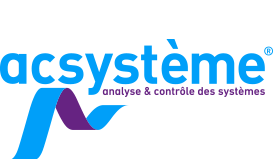Introduction to automatic control
Automatic control represents a part of process automation. In specialists’ lingo, control system includes all devices and processes related to computing: sensors (measuring instruments), actuators (motors, valves…) or electronic devices for control (panels, industrial network, electrical cabinets, calculators…).
Automatic control is the mathematical side of this field of activities: it determines the way how quantities – which affect the system to control – are calculated (for instance, motor speed while opening a valve) according to measurements and operator objectives.
The most simple control system is the thermostat (like in an electric radiator or an iron). It only consists of a bimetal that turn the heating device on when temperature is below a threshold (<18 °C) and off when above another threshold (>20 °C). In this example, the regulated physical quantity is the temperature; the mean is the heating power. Temperature setpoint is the aim chosen for the quantity (19 °C for instance).
This kind of control is called “Bang-bang control”: either we act (thoroughly heat) or we do nothing. It solves a lot of basic cases; nevertheless it is highly restricted when it comes to complex industrial structures:
- The previous example attested that the temperature will always oscillate between two thresholds (18 and 20 °C). To limit oscillations, it is possible to bring thresholds closer (like 18.9 and 19.1 °C).
- Actuators are heighly solicited with bang-bang control as you can only choose between all and nothing. It may be admissible with an electrical resistance, but it is not with a hydraulic actuator… Moreover, the closer thresholds are, the more difficul it is for the equipment.
To fix these problems, we use “continuous” control, meaning it can gradually fluctuate within a working range. For instance, an electrical motor can be continuously supplied by a varying voltage that changes between 0 and 10 V (so a valve can be more or less open…). Control command is then harder to compute.
The major part of continuous control systems is design with a “PID” shape: proportional-integral-derivative controller. First of all, we estimate system deviation: the difference measured between input (setpoint) and the output (like temperature). The control quantity (for instance, the heat power) is then computed as the sum of three terms:
- one proportional to the system deviation (the farther from the setpoint we are, the stronger the control command will be. If there is a perfect match, we do nothing)
- another is proportional with the system deviation integral (the farther from the setpoint we are, the faster the control command will change. If there is a perfect match, we do not change the input but we still apply it)
- last is proportional to system deviation derivate (the faster we are moving away from the objective, the more significant the actions will be to reverse the current trend. Whereas when we are close to the setpoint, we take it easy)
Here, we are dealing with the most widespread and simple of control systems. Some systems are a lot more sophisticated and require a suitable control loop, such as for example coupled ones. For instance, with a boiler in a thermal power station, there are three ways to affect physical quantities (heating power, valve opening and cold water injection). But each manner individually modifies the others: this phenomenon is called “coupling”. In such a case, it is extremely difficult to set three PID control loops together because any modification of one of them also affects the other two. It results in the use of higher-performance techniques, based on system modelling: “advanced” automatic control.
The same methods are used with onboard electronic systems, responsible for controlling components of automotive, railway, underwater or aerial vehicles. The mission is to regulate speed, keep a temperature, ensure anti-skid, correct trajectory or assist driver with maneuver (emergency braking…).
Automatic control encompasses all of these techniques, and the mathematical tools used to understand and implement them.

